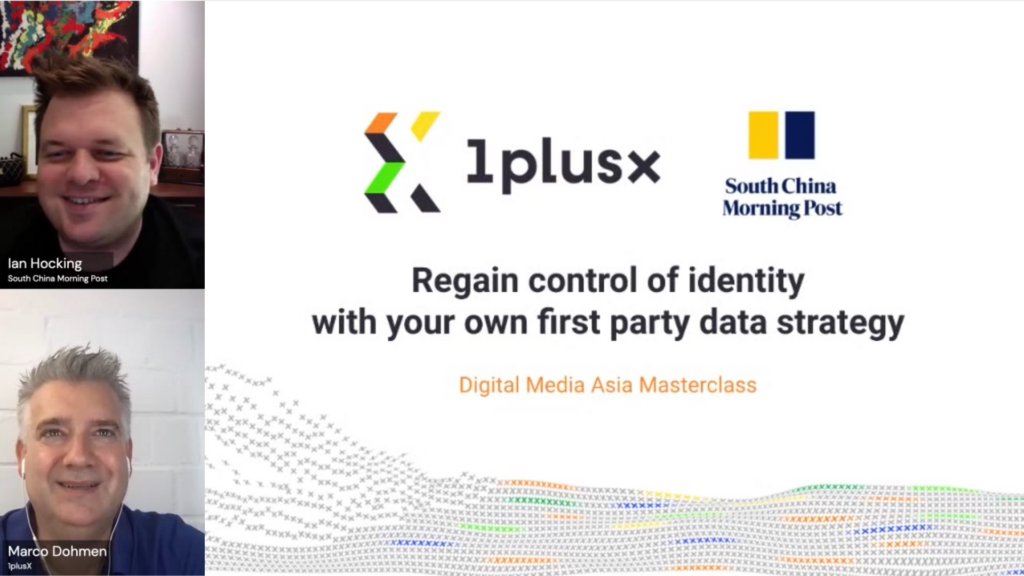Regain Control of Your Identity with Publisher SCMP
Early adopter South China Morning Post created a paradigm shift in the industry when they moved to a solely first-party data strategy. Here are the key insights. 🚀
Index:

Early adopter South China Morning Post created a paradigm shift in the industry when they moved to a solely first-party data strategy. Here are the key insights. 🚀
The advertising ecosystem is evolving. Whether you’re just starting to think about a first-party data strategy or you’re well on your way, there’s no denying that there’s a need for it. At our recent Digital Media Asia masterclass with Ian Hocking from South China Morning Post, Ian gave key insights into what they do differently than other publishers and left the audience with key takeaways for developing their own first-party strategy. If you missed the masterclass, you can watch the replay here. If you just want the highlights, keep reading!
Watch the masterclass recording here with:
Ian Hocking, Vice President, Digital at South China Morning Post
Marco Dohmen, VP Sales at 1plusX
Just the Highlights
Key Market Trends
The key trends in the marketplace are towards first-party relationships and away from third-party data. I think it’s important that we separate the two out. So there is an identity that is managed through some kind of identifier. And there’re countless ways to do that right now. But substantially, quite a few of them are being phased out. Fingerprinting techniques are going away. Third-party cookies are going away. Mobile IDs are going away. And so if those channels are becoming more and more difficult to use and to identify and use for buying purposes, you really have to find some safe alternate solution.
As a publisher, we tend to focus on first-party cookies, which are fantastic because they’re persistent, i.e. they last for a long time and we can build really good profiles based on them, and they’re not locked by any platform. We can use them freely within our environment. But they do have a small problem in that they’re not really useful for moving between different publishers. So if you want to activate that data through the open web, you have to find other ways.
Identities are definitely a really big thing and data sort of sits alongside it. Do you choose a first-party data route or third-party data route?
First-party Data Route
For the South China Morning Post, we moved to 100 percent first-party data nearly three years ago, and that’s been revolutionary to us. It’s meant that instead of seeing our customers through somebody else’s eyes and probably aggregated slightly low-value data, we’ve been able to move to known quality, transparent data for everyone that comes to our site and build a much better knowledge of what they like, what they don’t like, and build products and services for both internal and external purposes of that.
All publishers, no matter how niche or large you are, sit on a tremendous amount of data. And what surprised us in this journey was how quickly we went from being reliant on third-party data to be able to execute just about everything that we do, in fact, everything that we do on first-party data only. And that makes a huge difference to our business. It really didn’t take us long – maybe from the point of appointing [1plusX] as our CDP to being able to run campaigns on for clients – probably we’re talking about three months worth of work. We didn’t just go for a basic setup, we went for quite a significant setup. We’re asking our product guys to do the full-site tagging, and we’re starting to integrate just about every API and data source that we could have around the business into 1plusX so that we got as much data as possible to build that profile to understand users. It’s definitely one of the reasons that we selected 1plusX — that they had such great connectivity both internally to our data tools, but also externally to our activation platforms.
Reaction from the Demand Side
People are really receptive to those that can offer privacy compliant, really high-quality, first-party data for sure. And buyers have been working very closely with us on the majority of their campaigns. In fact, well over 90 percent of our campaigns are booked with first-party data now. But we do need to do some education about what data is really useful for. A lot of people kind of assume that when you just put the tightest level of targeting on a campaign as possible, that that’s what’s going to drive the best possible results.
In fact, what we’re learning, and clients are learning with us, is that what we want to do is use data to drive efficiency, to exclude irrelevant users, and make sure that we’re on target for advertising campaigns, but don’t want to target it to death by using every increasingly small circle of data and talking to just fewer and fewer people. Just because we’re now able to target elderly ladies in Hong Kong that like puppies doesn’t mean that we should do so, even if you’re a box food manufacturer. We should be talking to a larger group of individuals and bringing them on that journey. So as much as this is an extremely powerful tool, we also really need to educate about the right way to use it.
Selecting a Tech Partner
When we went through this process, we spoke to a number of partners to provide a data service from traditional DMPs through to a modern CDP. And the thing that really made a difference to us was the data transparency. We want to know exactly where the data came from, what quality it is, how we’re expanding it, and what the quality is at the end of that expansion. And not everyone, in fact, very few people, can do that. And the reason that very few people can do that is that they don’t really want to let you see machine learning. They don’t really want you to understand the magic that makes the platform so good and obfuscating that in any way, just even if they’re just saying, “Look, it’s great, but believe us that’s happening, you don’t have to worry,” is no longer acceptable. Especially for someone like SCMP that wants to use that data to make their own buying decisions on their platform for things like subscriptions. So we had to have 100 percent transparency. And we had to understand how that machine learning works in some detail to be able to use ours in the way that we want, both for our clients and ourselves. And it was that that really made us opt for 1plusX as a platform. The machine learning element is crucial to any publisher, any media runner. You need to be able to take high-quality seed data and apply that to your base in a known and strategic way that gives you control over the quality of that data.
Real-time Targeting
It’s easy to forget, but that is crucial. You want to be able to apply data that you’ve learned ideally on the next impression. A user lands on your site, you go, “Oh, that’s such and such a user,” and then the next impression, you’re able to monetize that at a higher yield than you would’ve been if they were still unknown or building a profile. And so second impression targeting is hugely important; the readiness of that data is hugely important.
I often think that when we talk about this, people assume that it’s only really relevant for really large publishers and lesser for niche publishers. But I really think that niche publishers have a huge thing to say here. If you have a niche publishing site, you probably have really strong content in a particular area that’s extremely valuable to some people and with very loyal customers. And that data then becomes really unique and really interesting to buyers. But you need to be able to tap into it and unlock it. And so having a great CDP is the way that you do that and that’s how you distinguish yourself from the rest of the long tail of the marketplace. This is definitely something that can be activated at really any size of the company.
A Final Thought
First of all, this is the truth: you have to move to first-party IDs. And if you haven’t already, you need to get on it as soon as possible. Then you can really build advertising value by exploring the data that makes you unique.
The more you delve into what makes you different, the better. For a long time, homogeny was the way forward, having the same ad units available on every platform was the thing that you wanted to be successful. Today it’s unique and so really amplifies that.
And lastly, share your data across the organization. It isn’t just good for advertising; it’s good for marketing, it’s good for events, it’s good for your data team, it’s good for everybody. And so having a great central resource that everyone can tap into really helps to build value to the effort you’ll put into putting it together.
 Data Monetization (in a Privacy-first World) for Publishers
Data Monetization (in a Privacy-first World) for Publishers
 Stop 3rd-Party Cookie Deprecation From Impacting Revenues
Stop 3rd-Party Cookie Deprecation From Impacting Revenues
 How Publishers Can Keep Up with Digital Advertising Privacy Changes
How Publishers Can Keep Up with Digital Advertising Privacy Changes